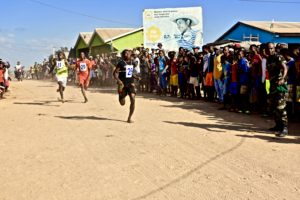Into Madagascar’s Wild West — Part III
To Read Part One Click Here. To Read Part Two Click Here. It was June 24, and our departure to Bekopaka was delayed by a massive crowd lining the streets of Belo-sur-Tsiribihina. The whole town had come to watch events that were part of their Independence Day celebrations. Madagascar gained independence from France on the June 26, 1960, and contemporary celebrations begin well before June 26 each year. Malagasy flags fly over every residence and shop from the beginning of June, and in Belo-sur-Tsiribihina, a series of races take place. We watched as runners made their way through the streets and past the cheers of the crows; they ran the 3km perimeter of the town, ten times! Motorcycles and cars filled with buoyant supporters sped alongside the runners, making their encouragements loudly known. Before finally setting off, we saw that the next event was a bicycle race.

After a long drive to Bekopaka and pitching camp on the border of the Tsingy de Bemaraha national park, we had the whole evening to discover the village. Right next to the village center, we came across the local football pitch and saw a game underway between Bekopaka and Maintirano. As we were watching, we noticed packs of children gathering into a circle at the village center. A traditional Moraingy fight was to take place. Two teams of two ‘kidabolahy’ (young men) positioned themselves into the circle and attempted to lift the others out of the ring.The main focus for them, however, was landing a single strike to their opponent. Once a hit was landed, they all backed off respectfully and began again. Traditionally, the elders are there to judge the fighters’ strengths, as the strongest fighters are worthy of the village’s admiration, but in this fight, any elder that walked into the ring was promptly lifted out of the ring by the kidabohaly. Moraingy fights usually have ‘salegy’ background music, but the children in charge of the speakers played the same awful, ear-piercing flute tune at full volume. The tune only had six notes, played on repeat, and I still shudder when hearing it. Even now, Max will deviously play a recording of the tune just to mess with me.

With a 5:00 a.m. wakeup the following morning, we met our park guide R.J. and prepared for a four-hour hike winding through the Tsingy maze — in Madagascar, guide fees are crucial to fund the conservation of the national parks. First passing through forests, R.J. spotted a Red-Tailed Sportive Lemur in a tree, which was a pleasant surprise — the national park is famous for its Tsingy geological formations, and I wasn’t expecting to see my first lemur here. As the hike went on, we came across the beginning of the limestone rocks. The Tsingy is a massif of limestone pinnacles that evokes a phenomenal karstic scenery, that towers over the deciduous forests and plains of the Tsingy de Bemaraha national park.
By forces of erosion, weathering, and tectonics, they were formed when dinosaurs still roamed the earth. We made our way through narrow canyons, having to walk sideways or else we couldn’t move forward. Some parts of the maze were in pitch-black caves, with openings no bigger than ourselves. Then hiking in a mix between forest cover and geology, we scrambled and climbed over massive roots and rocks, until we came across an almost vertical limestone column. Carabiners attached, and with plenty of footholds, we scaled the twenty-meter peak, giving way to a splendid view. The numerous Tsingy points, atop a brilliant contrast of green trees and grey column bases, expanded into the distance. We walked on top of the massif, with no defined path, placing our steps between jagged tips. The only sign of civilization here was a single metal footbridge to cross from one ridge to another, that swayed with every stride.

In the afternoon, we hiked through the “Small Tsingy”, which consists of the same karstic formations, just smaller. Though exhausted from the day’s hikes, R.J. offered to take us on a sunset walk to see Mouse Lemurs and chameleons. Now, June 25, the eve of Independence Day, is when the real party begins. Everyone in Bekopaka was having a blast, with plenty of alcohol and music to celebrate. R.J. and Rolland were hilariously impaired by sunset, and when Rolland drove us back to the campsite, at about 10km/hour, he only kept his eyes open to spot chameleons — for which he stopped the 4X4 every time to stand next to proudly. We had an early rise in order to drive down to Morondava the next day, but nothing should or could get in the way of the country’s biggest celebration.
On Independence Day, we made our way south, with a few stops on the way. The first was due to a flat tire, but breakdowns are so common that nobody was taken by surprise. We stopped by a few famous baobabs, namely the “Sacred Baobab” and “Lover’s Baobab”, which are some of the most photographed places in Madagascar, as well as where we made our last stop: L’Allée des Baobabs. On a stretch of the Route Nationale 8, colossal baobabs form a natural avenue. With the sun casting shades of pink and orange on the brown trunks, it is one of the most striking places I have watched a sunset.
That evening, after such a gorgeous sunset, we arrived into Morondava on the coast, marking the end of a journey that none of us will forget.
